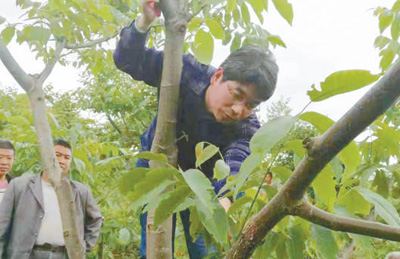


Pan Xuejun shows how to prevent diseases for a walnut tree. (Photo/Hu Jingming)
Thanks to Pan Xuejun, a professor in Guizhou University, the once poverty-stricken Hezhang County in Bijie City, southwest China’s Guizhou Province, has witnessed a significant increase in its output of walnuts and a 5,000 Yuan (about $726.9) rise per capita in people’s annual incomes.
Pan was sent to Hezhang County to assist the local people with their poverty alleviation endeavors in 2006, when he found that the place has great natural conditions for walnut trees.
Although Hezhang Country was endowed with rich walnut tree resources and had a long history of growing walnut trees before Pan’s arrival, it didn’t have a dominant specie of walnut tree and had been relying purely on the nature for yield.
Believing that to develop the walnut industry in Hezhang County, the quality of the walnut tree species was the first issue to be dealt with. Pan spent two years traveling across 88 cities and counties of Guizhou to select high quality walnut tree species. Finally, he selected four premium quality walnut tree species from over 1 million, which he named the “Qian Walnut” series (Guizhou Walnut series).
Since the traditional way of growing walnut trees means it can take up to 10 years for a walnut tree to bear fruit, Pan thought of grafting, as “by grafting the premium species on other trees, we can make sure that the walnut trees will have adequate and balanced nutrition, thus being able to not only increase the output and quality of the fruit but also reduce the time it needs before the trees can produce fruits,” according to Pan.
“The grafted seedlings start to fruit four years after they are planted, and the output of the grafted walnut trees can reach 150 kilograms per mu (One mu is equal to 667 square meters) in eight years,” said Pan with pride.
Within the past 13 years, the planting area of walnut trees in Hezhang County increased from 140,000 mu (9,338 hectares) to 1.6 million mu (106,667 hectares), becoming a pillar industry of the county in the process of poverty alleviation. During this time, Pan learnt much of the local dialect and is affectionately nicknamed Walnut Pan by the local people.
Seeing significant increases in output and quality of the walnut trees and fruits, local planters began to trust Pan more and more. They followed almost every piece of Pan’s advices in growing and tending to the trees, which has yielded great outcomes for them.
Li Fugui, a local villager whose family used to be one of the impoverished families in the county, built a cutting orchard under the guidance of Pan. Now Li is a grafting management technologist, while his family has shaken off poverty and enjoys an annual income of more than 60,000 yuan.
Since 2006, Pan has been spending two thirds of his time every year in fields, showing local farmers the techniques in person. “If I just teach them the theories in classrooms, they would find it hard to understand. But if I show them in the fields, they understand it immediately,” said Pan.
Pan has cultivated more than 200 technologists in Hezhang County over the past 13 years, with the fruits of his labor shown through the money-spinning walnut industry with local orchardists.
Pan has yet more goals for the county. “A walnut is not just about the fruit. Walnuts can be used to make walnut milk, walnut oil, walnut sugar, and walnut wine, etc. I hope to develop the walnut industry of the county into an industrial chain with high added value, so that the local people can get rid of poverty faster,” said Pan.
 Fire brigade in Shanghai holds group wedding
Fire brigade in Shanghai holds group wedding Tourists enjoy ice sculptures in Datan Town, north China
Tourists enjoy ice sculptures in Datan Town, north China Sunset scenery of Dayan Pagoda in Xi'an
Sunset scenery of Dayan Pagoda in Xi'an Tourists have fun at scenic spot in Nanlong Town, NW China
Tourists have fun at scenic spot in Nanlong Town, NW China Harbin attracts tourists by making best use of ice in winter
Harbin attracts tourists by making best use of ice in winter In pics: FIS Alpine Ski Women's World Cup Slalom
In pics: FIS Alpine Ski Women's World Cup Slalom Black-necked cranes rest at reservoir in Lhunzhub County, Lhasa
Black-necked cranes rest at reservoir in Lhunzhub County, Lhasa China's FAST telescope will be available to foreign scientists in April
China's FAST telescope will be available to foreign scientists in April "She power" plays indispensable role in poverty alleviation
"She power" plays indispensable role in poverty alleviation Top 10 world news events of People's Daily in 2020
Top 10 world news events of People's Daily in 2020 Top 10 China news events of People's Daily in 2020
Top 10 China news events of People's Daily in 2020 Top 10 media buzzwords of 2020
Top 10 media buzzwords of 2020 Year-ender:10 major tourism stories of 2020
Year-ender:10 major tourism stories of 2020 No interference in Venezuelan issues
No interference in Venezuelan issues
 Biz prepares for trade spat
Biz prepares for trade spat
 Broadcasting Continent
Broadcasting Continent Australia wins Chinese CEOs as US loses
Australia wins Chinese CEOs as US loses